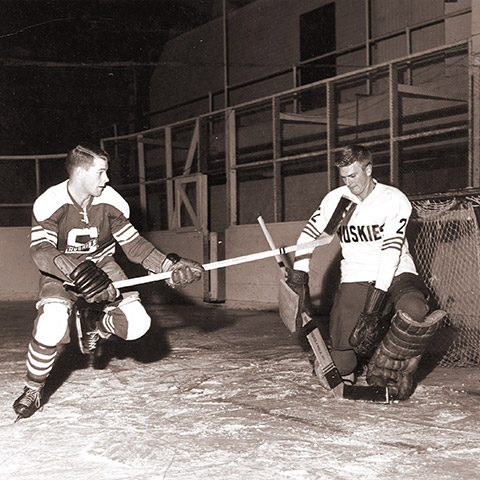Remembering Rutherford Rink
Although there was a team as early as 1910, University of Saskatchewan hockey was first played on campus on natural ice in late 1929, within what was originally called the ice drome.
By Michael P.J. KennedyThe official opening, which included an appearance by Premier James T.M. Anderson and a “fancy skating exhibition” did not occur until January 23, 1930. With the death of the Dean of Agriculture William Rutherford that same year, the building was named Rutherford Rink in his honour. The initial cost was $47,000 for the brick-faced building, which held a small ice surface and was used not only for varsity hockey, but also for recreational skating, band nights, and winter carnival activities.

Many stories in my book Dogs on Ice: A History of Hockey at University of Saskatchewan document the use of the rink for hockey, recreational skating, and as a military drill facility. My personal experience with Rutherford in any meaningful way started when I came to teach English at the U of S in 1991.
For years I have sat in a lawn chair I bring to every game. To this day, a number of us old-timers view the games up against the glass in the northeast corner of Rutherford. I have gone years without missing a single men’s hockey home game.
Like most spectators in Rutherford Rink, I lament the shortcomings of the rink, which has a well-deserved negative reputation for its lack of spectator amenities. It is cold, the sightlines obstructed by steel posts (and thick black netting seemingly recycled from a Nova Scotia trawler!), the seats are backless boards bolted to concrete, the sound system is barely audible, the concession offerings are limited, and the two public washrooms are small and spartan.
Players are forced to use crowded dressing rooms, with the men jammed into a space beneath the media deck, while the women have to change in a construction trailer attached to the back of the rink. Showers are few, and training facilities consist of a few stationary bicycles. Through private donations and some university funding, the women’s trailer has been made relatively comfortable, while Smuker’s Lounge (named in honour of former Huskie Cody Smuk, who passed away from cancer) provides some amenities for the men’s team to study or relax with fellow players.
Rutherford’s small ice surface and close-up spectator area and walls make it intimidating for opposing teams. Hitting one of the overhead cross-girders results in rust filings falling onto the ice creating “rust delays” at most games, but this adds to the unique character of the facility. Over the years, Huskie players have said they like performing in the early 20th century structure, with its retro small-town Saskatchewan feel. Because it is so cold, the ice is usually good and the lack of player amenities in a way draws the team together.
Most of the fans at games are family or friends of players, or true Huskie fans who appear game-after-game. For those who continually stand or sit in the freezing confines of the building to support their team, there is a bond which creates a collective loyalty to the team and the shared experience at Rutherford Rink. One of the joys of games at the rink is the friendly interaction among spectators of all ages, as serious hockey fans and family and friends of players mingle with parents of young Timbits players who get to skate between periods.
Like many others, I have seen the plans for the new Merlis Belsher Place and recently had the opportunity to tour the facility. What an incredible place it will be when it opens. I will miss Rutherford’s unique old-school environment, but it will be a pleasure to be warm at a game, to have comfortable seats, numerous washrooms, concession choices, and excellent sightlines and sound system to provide an enjoyable experience.
Similarly, it will be good for the players to have the training, dressing room and ice facilities which allow them to perform at a high level. The women’s and men’s teams certainly deserve quality facilities after going decades without basic amenities.
Each game has been a positive experience for me as a fan and one who appreciates the speed, skill and strategy of university hockey. However, if I am to pick what has been the greatest game for the women’s team that I have experienced, I would point to the playoff series in 2014 when the Huskies shut out the University of Regina Cougars 1-0 in double overtime in the opener, dropped the second game in quadruple overtime 2-1, and clinched the series with a 2-1 double overtime victory. The rink was filled and the hockey was excellent, in a landmark series for the women’s hockey program.

In recent years, the men’s team’s most exciting game would also be a series, in fact two series. The first was in 2012 when the Huskies captured a best-of-three playoff series versus the University of Calgary Dinos. After losing the opener 2-1 in overtime, the Huskies won the second 4-1, and then captured the Canada West championship with a 2-1 triple overtime win. What made this series so special was the quality of play, but also the way it attracted fans to Rutherford. The seats and standing room areas were filled almost an hour before puck drop and for the first time in my memory, fans were turned away since the building could hold no more people!
The second series that comes to mind was the 2016 Canada West final against arch-rival University of Alberta. The crowds were loud and engaged throughout, but it was the fact that the Huskies swept the Golden Bears in two straight games (4-0 and 3-2) and had the trophy presented on home ice that made it special. I recall how players, family members and fans, including the family of the late Cody Smuk, who had passed away the year before, assembled on the ice to celebrate.
Smuk’s family was included in the official Canada West championship photograph, which brought out the emotions in many of us.
There are so many other games that I have enjoyed as a long-time fan and team historian. One especially funny incident occurred around the turn of the century when two players crashed into the Plexiglas in front of where I was sitting in my lawn chair. The glass popped out and was falling toward me as I stretched out my hands to grasp this heavy Plexiglas panel. As I stood there and play was whistled down, people laughed and public-address announcer Bruce Gordon commented about how Rutherford Rink is the only place one could see a professor pitching in with rink maintenance.
As fellow fans roared with laughter, I continued to stand there holding the glass and said to those around me: “This thing is heavy ... I am holding it out of self-preservation, not trying to be helpful to the maintenance staff!”
Sitting by the northeast exit door, many nights the cold air from outside permeates the area, and of course there are many games where the frost drops from the uninsulated roof boards and inside the rink is indeed colder than outdoors. Asbestos was removed several summers ago when it was found that the pipes above the spectator area were wrapped in the material.
As far as players are concerned, like a father asked to proclaim his favourite child, I do not want to name any one player, since I have taught and interacted with so many excellent individuals from both the men’s and women’s teams over the decades. I will, however, note my strong support for the Huskies student-athlete model which has been a big part of the university.
Students learn so much about themselves and working toward shared goals, time management, dealing with challenges, etc., through their commitment to a team while they are studying at the post-secondary level. The successful players are those who excel in their chosen field of study and are also able to play their sport at an elite level. Many members of the hockey teams have been models of how successful student-athletes can be.
I have mixed emotions about the Huskies leaving the cozy confines of Rutherford Rink. It has been such an integral part of Huskie men’s and women’s hockey and recreational and alumni activities over the years. Yet, with the multi-purpose benefits of Merlis Belsher Place and integration of Saskatoon-wide activities with university events in a beautiful new facility, new history will be made.
Top (A-759) and inset (A-1046) photos courtesy of University Archives.
Michael P.J. Kennedy is a former long-time English lecturer at the U of S and a Huskies hockey historian who has installed a display of photographs and historical information at Rutherford Rink entitled A Place to Call Home: From Rutherford’s Rink to Merlis Belsher Place.

